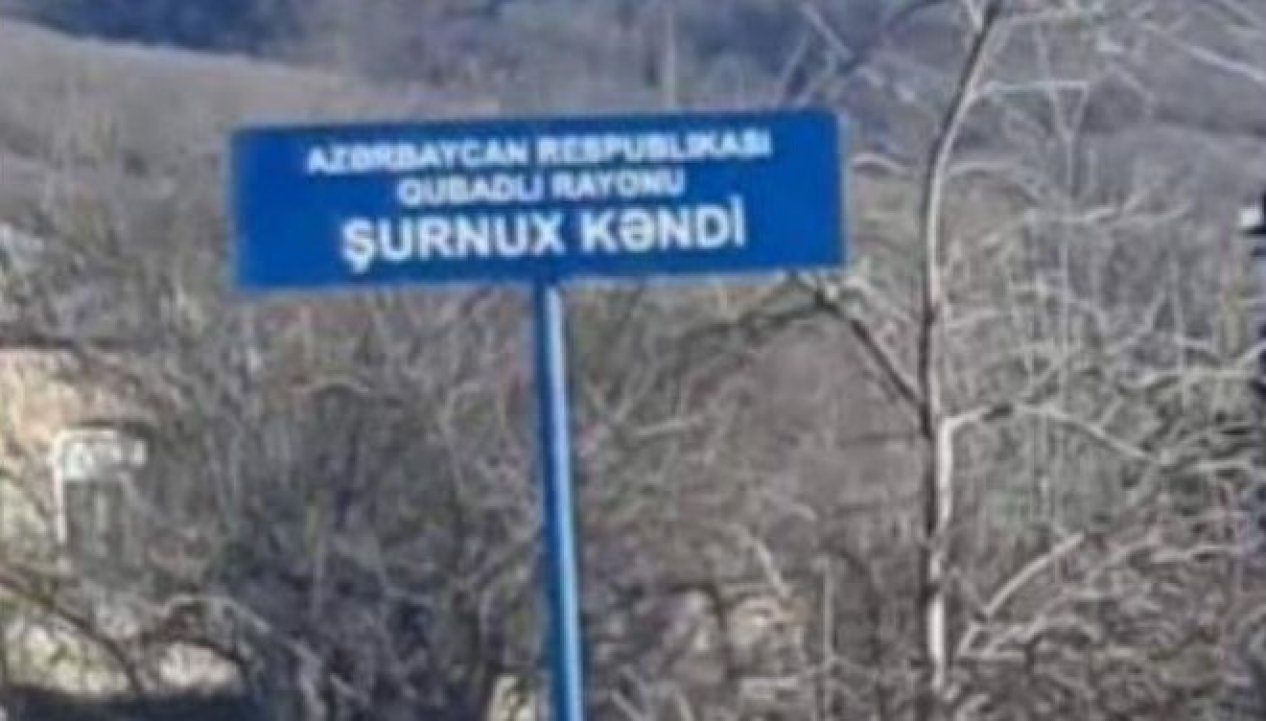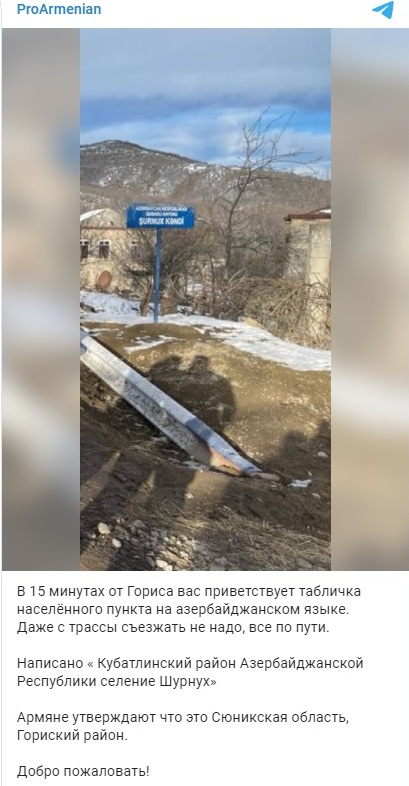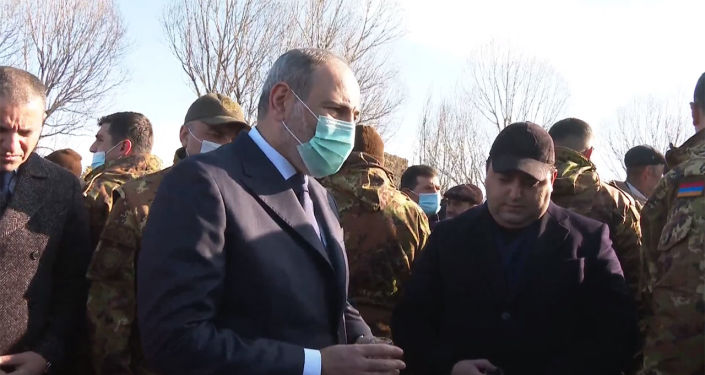
The Azerbaijani servicemen are carrying out active engineering work in the part of Shurnukh under their control and in its environs, chief of the village Hakob Arshakyan told Sputnik Armenia. "In the part of the village that came under their control, they seem to be establishing a post on one of the heights in front of us," Arshakyan said. The chief of the village, divided into two parts, is sure that there is some purpose behind this, and the Azerbaijani side is clearly plotting something. "Even a child understands that they are preparing something," Arshakyan said. According to him, every night Azerbaijani columns (7-8 cars) enter the territory of the village closest to Shurnukh.

In early January, Armenia handed over 12 houses to Azerbaijan in the village of Shurnukh, Syunik region, which, as a result of the Karabakh conflict, ended up on the border of the two countries. Houses with adjoining land plots were transferred to Azerbaijan within the adjustment of borders. Their former owners moved to live with relatives. It was originally planned to transfer 11 houses to Baku's control. But then the owner of another house decided to leave it, not wanting to live next to the Azerbaijanis. The head of the village Hakob Arshakyan said that the Azerbaijanis have already established a checkpoint at the entrance to their section of the village. Armenian residents were advised not to walk alone and not to let livestock there, "to be as careful as possible."
These territories are located outside the former borders of the Armenian SSR in the territory of the Gubadli region of Azerbaijan. That is, Azerbaijan, having taken a part of the village, regained control over its sovereign territory.
Azerbaijanis once lived in the Armenian village of Shurnukh on the border with Azerbaijan, just like they lived in Kapan and Gugark, and like the Armenians lived in Sumgait and Baku. When the border between the Soviet republics became the front line, the Azerbaijanis left, just as they left Sevan, and as the Armenians left Chardakhli. The Armenians began to settle in the village. And when, behind the disappeared front line, everything began to be considered Karabakh, Shurnukh naturally expanded, and who then was interested in the fact that it was Azerbaijan?
Refugees who don’t return - an indisputable experience of post-Soviet wars, and post-Soviet people have lived for thirty years with this. But everything suddenly changed, and every smartphone now has a GPS, according to which it turns out that here, between neighboring houses or right in the courtyard, an internationally recognized state border passes. And how can someone argue if this Google map user has an army behind him or her that has just won the war?

Armenian telegram channels are distributing a photo of a greeting plaque in Azerbaijani installed at the entrance to the Shurnukh village of the Gubadli region of Azerbaijan.
Head of the REAL TV channel, journalist Mirshahin Agayev visited the village. There he was able to talk with one of the Armenian families. Judging by the footage filmed in the Armenian part of Shurnukh, people live in difficult social conditions. A villager named Stepan complains about the lack of water. The Armenians admitted that they moved to Shurnukh 30 years ago. According to them, Azerbaijanis used to live there, thereby refuting the information of Armenian officials that the Armenians are the indigenous inhabitants of the village.
The Armenians themselves don’t deny that they occupied territories and appropriated lands. Sputnik Armenia reports that the mountain range that rises next to Kapan is again returned to Azerbaijan. The word “again” used by journalists means that before the occupation, the mountain range was on the territory of Azerbaijan and was captured by the Armenians.
During the first Karabakh war (1992-1994), firing points were equipped there, the Armenian newspaper writes. From there, shelling of Kapan and the main roads was carried out, which became unsafe, despite the presence of huge protective embankments. They had to use long bypass routes, and the airport was completely paralyzed. Based on the logic of the war, the Armenian troops first took these commanding heights under their control, and over time, they significantly pushed the line of contact in this direction - up to Horadiz.
The Armenians also admit that, expanding the transport infrastructure during the occupation period, they also built roads on the occupied Azerbaijani lands. For 26 years of the truce, the transport infrastructure in Syunik has changed significantly, writes Sputnik Armenia. The road network was built without considering the former borders, based on the actual need and convenience of communications. Now these roads partially pass through Azerbaijani territory and local residents are already afraid to use them, and it takes time to lay new routes. That is, some villages lose their access to routes. In addition, in Soviet times, there were Azerbaijani settlements near some settlements, for example, near the village of Shurnukh. The Syunik people are alarmed that in the new realities this presupposes the appearance of not only civilians, but also military persons.

However, Armenian officials, commenting on the situation with Shurnukh, denied the legality of Azerbaijan's actions. Negotiations on the demarcation of the border between Armenia and Azerbaijan are held on the basis of documents, Armenian Security Council Secretary Armen Grigoryan told reporters.
Grigoryan repeated the statement of the Ministry of Defense, which emphasized that Armenia was not going to concede a single meter of its territory. When it comes to the remark that the enemy gains heights in the immediate vicinity of the border, from which it can keep a number of settlements at gunpoint, Grigoryan said: “Of course, this creates a number of difficulties for us, but we must understand that delimitation is underway. The talks are held, based on a number of documents."
In fact, Armenian Prime Minister Nikol Pashinyan also called on to come to terms with the situation. He stated that problems may arise in relation to the two settlements in the process of clarifying the borders with Azerbaijan.
"These are the settlements of Vorotan and Shurnukh, where there are certain issues with the borders, and they can lead to painful situations. But, I want to assure that the government will come up with appropriate compensations, the interests of our citizens will be fully protected. Potential property losses of citizens will be fully compensated by the government," Pashinyan said at a government meeting.
As is seen, Pashinyan admits the legitimacy of the actions of the Azerbaijani side, he doesn’t protest against the division of the village and promises compensation to the citizens.
Thus, we have proved that the Azerbaijani border guards are legally staying on the territory of the village liberated from the occupation. That is recognized by the Armenian officials as well.
As for the arrangement of the border post and the strengthening of the positions that bother Arshakyan, this is due to the need to ensure security. The Armenian side has repeatedly committed provocations at the Shurnukh site.

“On April 21, after the visit of Armenian Prime Minister Nikol Pashinyan to Zangezur, the Armenians committed a provocation. According to the press service of the State Border Service, Azerbaijani units located in the village of Seyidlar of the Zangilan region of the Azerbaijani-Armenian border, as well as the positions of the border service of the Federal Security Service of Russia, serving in this direction on the territory of Armenia, were shelled by Armenian servicemen.
On the same day, a group of 30-40 people, heading to the state border in the direction of the village of Shurnukh, Gubadli region, chanted anti-Azerbaijani slogans in Armenian,” the statement says.
Summing up, it is safe to say that the concerns of the head of Shurnukh village are unfounded. The actions of the Azerbaijani side don’t pose a threat to the Armenian population on the other side, but only pursue the goal of protecting the security of the internationally recognized border of Azerbaijan, in this case passing through the territory of the Shurnukh village of the Gubadli region of Azerbaijan.




















